What were some of the questions that needed to be answered after the civil War was over?
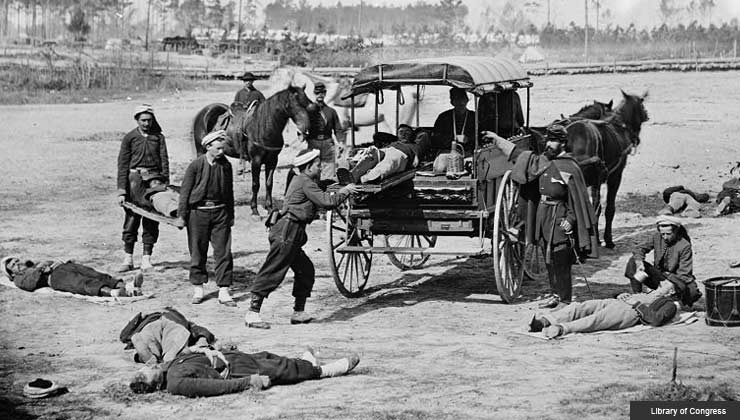
Library of Congress
An ambulance crew demonstrates the removal of wounded soldiers from the field during the Civil War.
En español | Echoes of the nation'south greatest fight — the Civil War — nonetheless reverberate from coast to coast.
Some band strong: of course the finish of slavery, perhaps the worst disgrace in the nation'south history. And the 620,000 ancestors lost. Other vestiges have weakened with the passage of time just are no less legacies of the four horrific, heroic years that shaped us equally one nation.
Here are eight ways the Ceremonious War indelibly changed us and how we live:
1. Nosotros have ambulances and hospitals.
The Civil War began during medieval medicine'south last gasp and concluded at the dawn of modern medicine. Each side entered the war with puny squads of physicians trained by textbook, if at all. 4 years later, legions of field-tested doctors, well-versed in anatomy, anesthesia and surgical exercise, were poised to make great medical leaps.
The nation'south first ambulance corps, organized to rush wounded soldiers to battlefront hospitals and using wagons developed and deployed for that purpose, was created during the Civil State of war. The idea was to collect wounded soldiers from the field, accept them to a dressing station and then send them to the field infirmary.
Doctors laid out the hospitals as camps divided into well-divers wards for specific activities such as surgery and convalescence. Women flocked to serve these hospitals as nurses.
Before the state of war, most people received wellness intendance at dwelling house. After the state of war, hospitals adjusted from the battlefront model cropped up all over the country. The ambulance and nurses' corps became fixtures, with the Ceremonious War's most famous nurse, Clara Barton, going on to establish the American Red Cross. Today'due south modern infirmary is a directly descendant of these first medical centers.
two. We prize America every bit a state of opportunity.
The Civil War paved the way for Americans to live, learn and movement nigh in ways that had seemed all but inconceivable just a few years earlier. With these doors of opportunity open, the United States experienced rapid economic growth. Immigrants likewise began seeing the fast-growing nation every bit a state of opportunity and began coming here in record numbers.
For many years Southern lawmakers had blocked the passage of state-grant legislation. Merely they weren't around after secession, and in 1862 Congress passed a series of land-grant measures that would forever change America's political, economic and physical landscape:
- The Start Transcontinental Railroad. Also known as the "Pacific Railroad," the world'due south starting time transcontinental line, built between 1863 and 1869, was at to the lowest degree partly intended to bind California to the Union during the Civil War. To build the line, the Union Pacific and Central Pacific railroads were granted 400-human foot rights-of-way plus 10 square miles of authorities-endemic state for every mile of track congenital.
- Homesteading in the W. The Homestead Human activity, enacted in 1862, provided that any adult citizen (or intended citizen who had never borne arms against the U.Due south. authorities) could be granted 160 acres of surveyed government land later living on it — and making improvements to it — for five years. Afterwards the Civil State of war, Wedlock soldiers could deduct the fourth dimension they had served from the residency requirement.
- The state-grant college organization. The Morrill Land Grant Act authorized the sale of public lands in every state to underwrite the establishment of colleges dedicated to the "agronomical and mechanical arts." It also required the teaching of military tactics. In time, the new law would give rise to such institutions of college learning every bit Michigan Land, Texas A&One thousand and Virginia Tech.
The same yr brought some other innovation — a national newspaper currency — that would literally backing the speedily expanding government and at the aforementioned time grease the wheels of commerce from coast to coast. In 1862, with the Wedlock'southward expenses mounting, the government had no way to continue paying for the war. "Immediate activeness is of nifty importance," Treasury Secretary Salmon P. Hunt told Congress. "The treasury is most empty." The solution: treasury notes begetting no interest and printed on the best banking newspaper, as proposed to President Abraham Lincoln by Col. Edmund D. Taylor, who would later became known as "the begetter of the greenback."
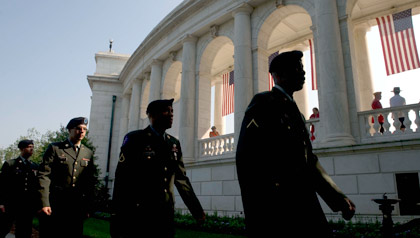
Nikki Kahn/The Washington Post/Getty Images
U.Due south. Army soldiers file past the amphitheater at Arlington National Cemetery on Memorial Twenty-four hour period 2010.
3. We begin summer with a tribute to fallen soldiers.
Always wonder why we display flags and memorialize fallen solders just as summertime gets under manner? Flowers, that'due south why.
The first memorial days were grouping events organized in 1865 in both the South and N, by black and white, just a month after the war ended. Speedily evolving into an annual tradition, these "decoration days" were usually ready for early summer, when the most flowers would be available to lay on headstones.
Decoration days helped the torn nation heal from its wounds. People told — and retold — their war stories, honored the feats of local heroes, reconciled with former foes.
After Earth War I, communities expanded the holiday to accolade all who accept died in military machine service, although the official national observance didn't begin until 1971.
This year Memorial Mean solar day falls on May xxx.
No matter where you are on Memorial Solar day, a national moment of remembrance takes place at three p.m. local fourth dimension.
4. We allow engineering guide how we communicate.
Abraham Lincoln was a techie. A product of the Industrial Revolution, Lincoln is the simply president to take held a patent (for a device to beacon boats over shoals). He was fascinated with the idea of applying technology to war: In 1861, for example, afterward being impressed by a demonstration of ideas for balloon reconnaissance, he established the Airship Corps, which would soon begin floating hot-air balloons above Amalgamated camps in acts of aerial espionage.
Lincoln also encouraged the development of rapid-burn weapons to modernize gainsay. Pulitzer Prize-winning historian James McPherson, the author of Tried by War: Abraham Lincoln as Commander in Chief, notes that Lincoln personally tested the "coffee-mill gun," an early version of a mitt-cranked machine gun.
Simply above all, Lincoln loved the telegram. Invented just a few decades earlier, the telegraph system had gone national in 1844.
As Tom Wheeler recounts in his book, Mr. Lincoln'south T-Mails: The Untold Story of How Abraham Lincoln Used the Telegraph to Win the Ceremonious War, the White House had no telegraph connection. Twice daily throughout his presidency, Lincoln walked to the telegraph office of the War Department (on the site of today'south Eisenhower Executive Part Building, just west of the White Business firm) to receive updates and to send orders to his generals on the front. He sent this one to General Ulysses Due south. Grant on Aug. 17, 1864: "Concur on with a bull-dog grip, and chew & asphyxiate, as much as possible."
Before Lincoln's mean solar day, letters and speeches were frequently long-winded. With the telegraph came the demand for concise communication. After all, every dot and dash of Morse Lawmaking carried a cost. Gone were the "wherefores," "herewith" and "hences." Flowery, formal speech was out.
Lincoln's Gettysburg and Second Inaugural addresses both demonstrate this new economy of phrase. "Events were moving too fast for the more languid phrases of the by," historian Garry Wills writes in his book Lincoln at Gettysburg. "The play a joke on, of course, was not but to exist cursory but to say a slap-up deal in the fewest words. Lincoln justly boasted, of his 2nd Inaugural'due south half-dozen hundred words, 'Lots of wisdom in that document, I suspect.'"
Non only did Lincoln's wartime dependence on the telegraph eventually lead to a moving ridge of investment in new communication devices, from the telephone to the Cyberspace (the latter invented, not coincidentally, for military machine employ), but information technology besides signaled the evolution of a language that morphs as chop-chop as the devices that instantaneously tweet our words around the world.
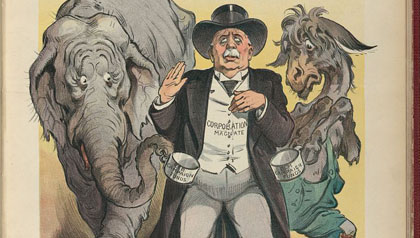
Udo Keppler/Library of Congress
A 1905 cover of Puck magazine employs the ass and elephant as satirical stand-ins for the political parties that took permanent hold during the Civil War.
5. We identify ourselves every bit Democrats and Republicans.
Earlier 1854, you might have been a Whig. Or a Free Soiler. But that twelvemonth the Republican Party was founded by anti-slavery activists and refugees from other political parties to fight the fe grip of powerful southern Democrats.
Equally the name of their party suggests, these activists believed that the republic'south interests should take precedence over united states'. In the years before the war, many northern Democrats defected to bring together the new party — and, in 1860, to elect Abraham Lincoln as the first Republican president — while southern Democrats led the march to secession.
The Democratic and Republican parties both survived the war and accept held their spots as the ascendant U.Southward. political parties ever since. The "Solid Due south," as information technology was known, protected the interests of agrarian Southern whites and consistently elected Democrats to Congress from Reconstruction through the early 1960s, when the national Democratic Political party's back up of the civil rights movement allowed the Republican Political party to begin making new political inroads below the Bricklayer-Dixon Line.
Inside a few years, Northward and Due south swapped party hats. Conservative southerners grew disenchanted with the Autonomous Political party's increasingly progressive platforms. Republicans capitalized on this with their "Southern Strategy," an organized plan to make headway there on a socially conservative, states' rights platform. In reverse, historically Republican strongholds in the Northeast began voting Democrat, establishing the pattern of red and blue that we run across on election-night maps today.
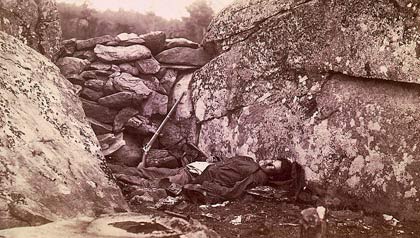
Alexander Gardner/Library of Congress
This 1863 photo shows a expressionless Amalgamated sharpshooter subsequently the Boxing of Gettysburg.
6. We see war "upward close and personal."
The Civil State of war was the first state of war in which people at home could absorb battle news before the fume cleared. Eyewitness accounts by reporters and soldiers were relayed via telegraph to the state's 2,500 newspapers, printed about immediately and and so read voraciously past citizens drastic to know how their boys were faring. The Civil State of war created a tradition of intimate state of war reportage that is yet with united states of america today.
Take this excerpt from a dispatch from George Townsend, who was but 20 when he began to cover the war for the New York Herald: "In many wounds the balls all the same remained, and the discolored flesh was bloated unnaturally. In that location were some who had been shot in the bowels, and now and so they were frightfully convulsed, breaking into shrieks and shouts. Some of them iterated a single discussion, equally, 'md,' or 'help,' or 'God,' or 'oh!' commencing with a loud spasmodic cry, and continuing the same discussion till it died abroad in cadence. The human action of calling seemed to lull the pain. Many were unconscious and lethargic, moving their finger, and lips mechanically, but never more than to open their optics upon the lite; they were already going through the valley and the shadow."
Tony Horwitz, a former war correspondent and the writer of Confederates in the Cranium and the forthcoming Midnight Rising: John Brown and the Raid That Sparked the Civil War, says that the front-line dispatches influenced his modern battlefront reporting. "Having been moved by soldiers' writing from the 1860s, I likewise sought them on strange battlefields, even going through the pockets of the Iranian dead at Majnoon and getting a Persian speaker to translate messages and diaries for me," he says. "This sounds ghoulish, I know, but I think you need to personalize the dead to bring home the shock and tragedy of information technology all. Otherwise, they're just statistics."
Photography, notwithstanding in its infancy, was not yet a function of the daily news bike. But the Ceremonious State of war was the commencement such conflict recorded past photographers (the nearly famous of whom was Mathew Brady). Because the archaic moisture-plate engineering science of the era required that subjects be still at the moment the photographic camera's shutter snapped, images of the era depict virtually every aspect of the war but i: battle. Simply that in time would change, as well.
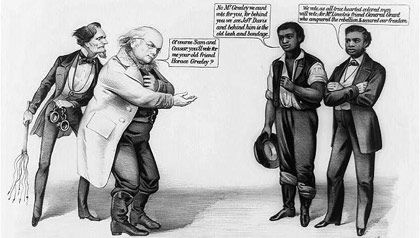
Currier & Ives/Library of Congress
A political cartoon by Currier & Ives depicts Horace Greeley, the newspaper editor and anti-slavery activist, and Jefferson Davis, the leader of the Confederacy during the Ceremonious State of war.
seven. We hold sure rights to exist sacred.
Recollect of these iii amendments to the U.Southward. Constitution, all ratified within five years of the terminate of the Civil War:
- 13th Amendment (1865). Section 1. Neither slavery nor involuntary servitude, except as a penalisation for crime whereof the party shall have been duly bedevilled, shall exist within the United States, or any place field of study to their jurisdiction. ...
- 14th Amendment (1868). Section one. All persons born or naturalized in the United States, and subject to the jurisdiction thereof, are citizens of the United States and of the State wherein they reside. ...
- 15th Amendment (1870). Section 1. The right of citizens of the United States to vote shall not be denied or abridged by the United States or past any Country on business relationship of race, colour, or previous condition of servitude. ...
Before the Civil War, the concept of liberty and justice for all meant little unless you were white and male. Going across the abolition of slavery, the 14th and 15th amendments were the outset extensions of citizenship and voting rights to minority groups.
Of course, half of united states of america — women — went without a voice until 1920, but the postwar laws set a precedent that eventually would lead to suffrage for all adults. Imperfect in practice over the side by side 100 years, voting rights finally gained protection through the 1964 Civil Rights Deed, ensuring that discrimination could never again disenfranchise any U.S. denizen.
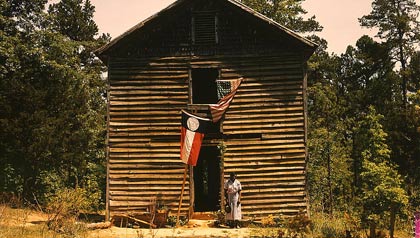
Jack Delano/Library of Congress
An unidentified woman stands in forepart of a building in Georgia that displays both the country and U.S. flags.
viii. We're all Americans.
Information technology took the State of war Between the States to make us one nation, indivisible. Before 1861, the United states were loosely tied entities and ever described equally a plural noun, as in, "The United States are in trade with France."
The war's bloodiest battle came at Gettysburg in 1863, with 51,000 casualties in just three days. Although the Union stopped Confederate Gen. Robert East. Lee's Northern invasion, young men's bodies littered the farms and gardens that had turned into a battlefield. Was the preservation of these united states worth the price in blood?
At a memorial for the dead, Lincoln intentionally called on the Wedlock to persevere for a single national ideal: "[T]hat we here highly resolve that these dead shall not take died in vain — that this nation, under God, shall have a new birth of freedom — and that government of the people, past the people, for the people, shall not perish from the earth."
The effect of Lincoln'southward Gettysburg Address, but 272 words from showtime to end, was radical and immediate. "By accepting the Gettysburg Address, its concept of a single people dedicated to a proposition, we have been changed," Wills writes. "Because of it, we live in a unlike America."
But the shift was more than a statesman's creation. It was too forged in the feel of hunger, disease, blood and decease shared for four years by the Union and Confederacy akin. Tellingly, the tradition of Civil War reenactments began fifty-fifty before the conflict had ended, as returning soldiers recreated battleground scenes at abode to educate the citizenry and pay tribute to their fallen comrades.
Ken and Ric Burns, in their introduction to the volume The Civil State of war, write: "Some events so pervasively status the life of a culture that they retain the power to fascinate permanently. They get the focus of myth and the anchor of meaning for a whole society."
The Civil War became our anchor. Ever since, whether big government or small-scale government, whether doves or hawks, blackness or white, we have all been one thing: Americans.
Betsy Towner lives in California.
Source: https://www.aarp.org/politics-society/history/info-04-2011/8-ways-civil-war-changed-lives.html
0 Response to "What were some of the questions that needed to be answered after the civil War was over?"
Post a Comment